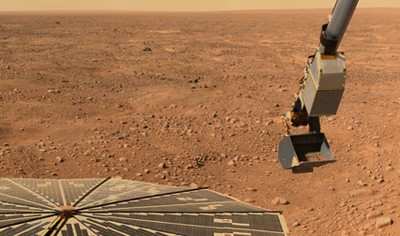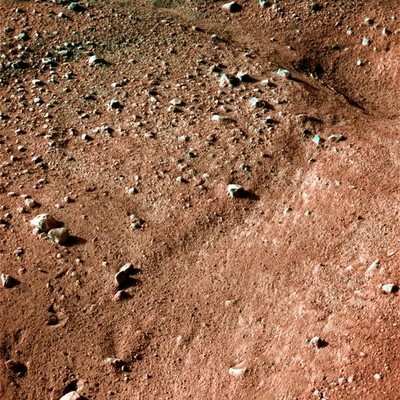Agency Works To Extend Lander's Lifespan
In a race against time and the elements, engineers with NASA's
Phoenix Mars Lander mission hoped to extend the lander's survival
by gradually shutting down some of its instruments and heaters,
starting this week... but time may be running out for the erstwhile
spacecraft.

On Wednesday, Phoenix entered safe mode in response to a
low-power fault brought on by deteriorating weather conditions.
While engineers anticipated that a fault could occur due to the
diminishing power supply, the lander also unexpectedly switched to
the "B" side of its redundant electronics and shut down one of its
two batteries. During safe mode, the lander stops non-critical
activities and awaits further instructions from the mission
team.
Within hours of receiving information of the safing event,
mission engineers at NASA's Jet Propulsion Laboratory, Pasadena, CA
and at Lockheed Martin in Denver, were able to send commands to
restart battery charging. It is not likely that any energy was
lost... but the switch to safe mode may prove to be an ominous
portent.
Weather conditions at the landing site in the north polar region
of Mars have deteriorated in recent days, with overnight
temperatures falling to --141F (-96C), and daytime temperatures
only as high as -50F (-45C), the lowest temperatures experienced so
far in the mission. A mild dust storm blowing through the area,
along with water-ice clouds, further complicated the situation by
reducing the amount of sunlight reaching the lander's solar arrays,
thereby reducing the amount of power it could generate. Low
temperatures caused the lander's battery heaters to turn on Tuesday
for the first time, creating another drain on precious power
supplies.

Science activities will remain on hold for the next several days
to allow the spacecraft to recharge and conserve power. Attempts to
resume normal operations will not take place before the
weekend.
"This is a precarious time for Phoenix," said Phoenix Project
Manager Barry Goldstein of JPL. "We're in the bonus round of the
extended mission, and we're aware that the end could come at any
time. The engineering team is doing all it can to keep the
spacecraft alive and collecting science, but at this point
survivability depends on some factors out of our control, such as
the weather and temperatures on Mars."
Originally scheduled to last 90 days, Phoenix has completed a
fifth month of exploration in the Martian arctic. As expected, with
the Martian northern hemisphere shifting from summer to fall, the
lander is generating less power due to shorter days and fewer hours
of sunlight reaching its solar panels. At the same time, the
spacecraft requires more power to run several survival heaters that
allow it to operate even as temperatures decline.
"If we did nothing, it wouldn't be long before the power needed
to operate the spacecraft would exceed the amount of power it
generates on a daily basis," said Goldstein earlier this week. "By
turning off some heaters and instruments, we can extend the life of
the lander by several weeks and still conduct some science."

Over the next several weeks, four survival heaters will be shut
down, one at a time, in an effort to conserve power. The heaters
serve the purpose of keeping the electronics within tested
survivable limits. As each heater is disabled, some of the
instruments are also expected to cease operations. The energy saved
is intended to power the lander's main camera and meteorological
instruments until the very end of the mission.
The Phoenix team has parked the robotic arm on a representative
patch of Martian soil. No additional soil samples will be gathered.
The thermal and electrical-conductivity probe (TECP), located on
the wrist of the arm, has been inserted into the soil and will
continue to measure soil temperature and conductivity, along with
atmospheric humidity near the surface. The probe does not need a
heater to operate and should continue to send back data for
weeks.
Throughout the mission, the lander's robotic arm successfully
dug and scraped Martian soil and delivered it to the onboard
laboratories. "We turn off this workhorse with the knowledge that
it has far exceeded expectations and conducted every operation
asked of it," said Ray Arvidson, the robotic arm's co-investigator,
and a professor at Washington University, St. Louis.
When power levels necessitate further action, Phoenix engineers
will disable a second heater, which serves the lander's pyrotechnic
initiation unit. The unit hasn't been used since landing, and
disabling its heater is expected to add four to five days to the
mission's lifetime. Following that step, engineers would disable a
third heater, which warms Phoenix's main camera -- the Surface
Stereo Imager --and the meteorological suite of instruments.
Electronics that operate the meteorological instruments should
generate enough heat on their own to keep most of those instruments
and the camera functioning.
In the final step, Phoenix engineers may turn off a fourth
heater -- one of two survival heaters that warm the spacecraft and
its batteries. This would leave one remaining survival heater to
run out on its own.

"At that point, Phoenix will be at the mercy of Mars," said
Chris Lewicki of JPL, lead mission manger.
Engineers are also preparing for solar conjunction, when the sun
is directly between Earth and Mars. Between November 28 and
December 13, Mars and the sun will be within two degrees of each
other as seen from Earth, blocking radio transmission between the
spacecraft and Earth. During that time, no commands will be sent to
Phoenix, but daily downlinks from Phoenix will continue through
NASA's Odyssey and Mars Reconnaissance orbiters. At this time,
controllers can't predict whether the fourth heater would be
disabled before or after conjunction.
 ANN's Daily Aero-Term (04.14.24): Maximum Authorized Altitude
ANN's Daily Aero-Term (04.14.24): Maximum Authorized Altitude ANN's Daily Aero-Linx (04.14.24)
ANN's Daily Aero-Linx (04.14.24) Classic Aero-TV: 'We're Surviving'-- Kyle Franklin Describes Airshow Life 2013
Classic Aero-TV: 'We're Surviving'-- Kyle Franklin Describes Airshow Life 2013 Aero-News: Quote of the Day (04.14.24)
Aero-News: Quote of the Day (04.14.24) Airborne 04.09.24: SnF24!, Piper-DeltaHawk!, Fisher Update, Junkers
Airborne 04.09.24: SnF24!, Piper-DeltaHawk!, Fisher Update, Junkers






